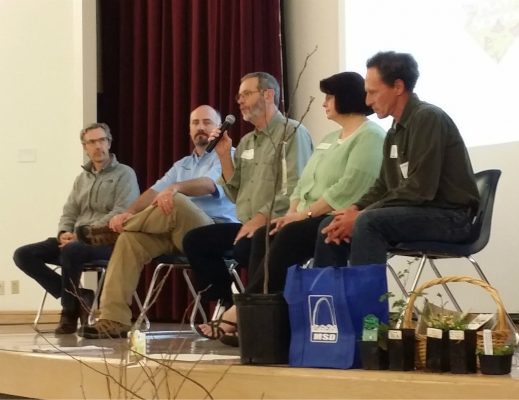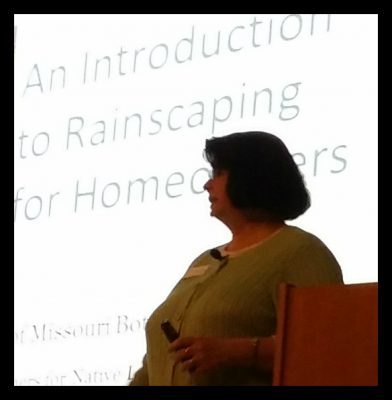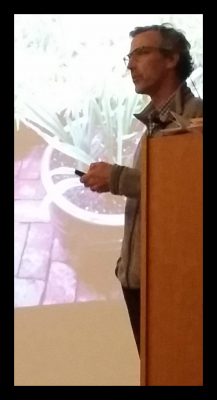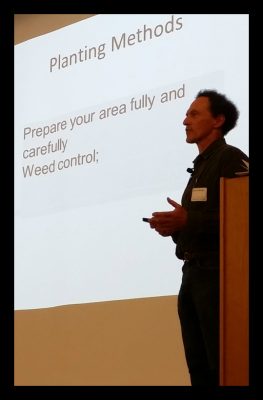Photos and blog by Marcia K. Myers
Blog Editor, Wild Ones – St. Louis Chapter

Panel discussion participants from left to right: Scott Woodbury, Perry Eckhardt, Dave Tylka, Glenda Abney, and Simon Barker
After a morning filled with useful information on how to get started landscaping with native plants and why it’s important, we returned after lunch to try and absorb even more ideas.
Glenda Abney, Director, EathWays Center at Missouri Botanical Garden, spoke about Rainscaping with Native Plants.
What is rainscaping? From the Missouri Botanical Garden’s website (which also includes information on designing and building a rain garden), “Rainscaping is any combination of plantings, water features, catch basins, permeable pavement and other activities that manage stormwater as close as possible to where it falls, rather than moving it someplace else.”
Research and planning are the important first steps.
- Is there standing water?
- Do you see any erosion?
- What types of features do you want?
- How much space do you have?
- Will you be able to maintain your design?
- Does the soil support the plan?
Abney recommends a percolation test to see if the chosen site is appropriate for a rain garden. What IS a percolation test? Basically, it determines the absorption rate. Instructions to conduct a percolation test
For many years, I’ve thought that utilizing rain makes a lot of sense as that water is free, helps the plants grow of course, and when used in a water feature, attracts wildlife. However, I wasn’t aware of the varied ways in which to incorporate that water into different landscaping designs.
Abney’s resources:
Scott Woodbury, Curator of the Whitmire Wildflower Garden at Shaw Nature Reserve, and Simon Barker, Chair, Membership Advancement Sub-Committee of Grow Native! and co-owner of Native Landscape Solutions, Inc. and Barker Horticultural Services LLC, both spoke about Basic Gardening Practices using Native Plants.
Woodbury suggested we draw a map of the house and experiment with various outdoor elements. He recommended using a garden hose to map out areas in the yard because it’s pliable. Those elements then need a frame, such as a split-rail fence, stones, or other materials to set them apart and help create visually-appealing spaces.
Other techniques:
- Designing the space with its purpose in mind
- Thinking about the view from inside the house as well as outside
- Repeating elements
- Balancing turf with other areas
- Using focal points, such as a boulder, stone wall, or large urn
Don’t forget the basic gardening practices of mulching, watering, and weeding.
Resources:
- Native Plant School
- Plant Calculator at Classy Groundcovers (calculates the number of plants you need)
Barker gave some good tips for beginners:
- Prepare your site fully and carefully [reduces work later and helps the plants establish] – including soil tests and adding organic matter
- Leave some bare dirt because certain insects [such as ground-nesting bees] need it
- Fresh mulch can pull the nutrients out of the ground
- Don’t overreact to insects and animals chewing on the plants; It’s probably normal
Barker recommended we think about the planting method we want to use:
- Plants
- Bare root
- Containerized
- Seed
Subsequently, there was a panel discussion with Q&A from the audience.
Also noteworthy, seven horticulture students at St. Louis Community College – Meramec received a scholarship from Wild Ones – St. Louis Chapter to attend this program.
I spoke with Beka Davis, a St. Charles County Master Gardener who received one of the scholarships. “I am so happy to be here,” Davis said. “I didn’t get to come last year.” Davis said she has natives in her landscape and started out with wanting to attract butterflies. That’s how she decided to become a horticulture student.
Other scholarship recipients:
- Mary Woodward
- Jennifer Trump
- Mary Jacobs
- Genevieve Ehrman
- Diane Lee
- Erin Gossenheimer
All of the speakers at Partners for Native Landscaping provided more information for beginners than what I’ve covered in this blog, making this event a bargain and a great program. Watch for the gala in 2017.




